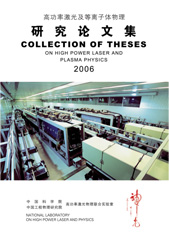
By means of Collins diffraction integral, the propagation expression of an ultrashort laser pulse passing through a spatial filter is derived. The effects of the magnification of spatial filter on pulse broadening and distortion of pulse-front for the ultrashort optical pulse are analytically deduced and numerically simulated. It is found that pulse broadening and propagation time difference of a laser pulse getting through spatial filter is proportional to the magnification. As a conclusion, in an ultrashort pulse laser system with a large aperture, the effect of pulse broadening and distortion of pulse-front should be considered.
Plasma scalding is one of the most typical laser damage morphologies induced by a nanosecond laser with a wavelength of 1053nm in HfO2=SiO2 multilayer films. In this paper, the characteristics of plasma scalds are systematically investigated with multiple methods. The scalding behaves as surface discoloration under a microscope. The shape is nearly circular when the laser incidence angle is close to normal incidence and is elliptical at oblique incidence. The nodular-ejection pit is in the center of the scalding region when the laser irradiates at the incidence angle close to normal incidence and in the right of the scalding region when the laser irradiates from left to right at oblique incidence. The maximum damage size of the scalding increases with laser energy. The edge of the scalding is high compared with the unirradiated film surface, and the region tending to the center is concave. Plasma scald is proved to be surface damage. The maximum depth of a scald increases with its size. Tiny pits of nanometer scale can be seen in the scalding film under a scanning electronic microscope at a higher magnification. The absorptions of the surface plasma scalds tend to be approximately the same as the lower absorptions of test sites without laser irradiation. Scalds do not grow during further illumination pulses until 65 J=cm2. The formation of surface plasma scalding may be related to the occurrence of the laser-supported detonation wave.
A phase retrieval algorithm which only needs to measure the intensity distribution at two positions to be effective is used to reconstruct the laser wave-front. Results are obtained from the phase retrieval algorithm in the visible band and the effects of the measurement error on the phase retrieval process are simulated. The algorithm is not sensitive to absolute amplitude measurement error, but is sensitive to the relative distribution of light intensity.
A new type of optical parametric chirped pulse amplifier is designed and analyzed for the amplification of pulse centered at 808 nm. A novel crystal, yttrium calcium oxyborate YCa4O(BO3)3 (YCOB), is utilized in the power amplification stage of optical parametric amplification (OPA). Noncollinear phase matching parameters in the xoz principle plane of YCOB, compared with those in BBO and DKDP, are analyzed by numerical simulation. The results show that YCOB rather than DKDP can be used in the power amplification stage of OPA to realize the amplification of chirped pulse to several joules with a gain bandwidth exceeding 100 nm. This can be used to gain a high intensity pulse of ~10 fs after the compressor.
Based on the theory of quasi-three-level rate equations modified by amplified spontaneous emission, the stored energy density and the small signal gain of the cryogenic Yb:YAG regenerative amplifier for a given geometry for pulsed pumping in three dimensions are theoretically studied using the Monte Carlo simulation. The present model provides a straightforward procedure to design the Yb:YAG parameters and the optical coupling system for optimization when running at cryogenic temperature. A fiber-coupled laser diode end-pumped cryogenic Yb:YAG regenerative amplifier running at 1 030 nm is demonstrated with a maximum output energy 10.2 mJ at a repetition rate of 10 Hz. A very good agreement between the experiments and the theoretical model is achieved.







